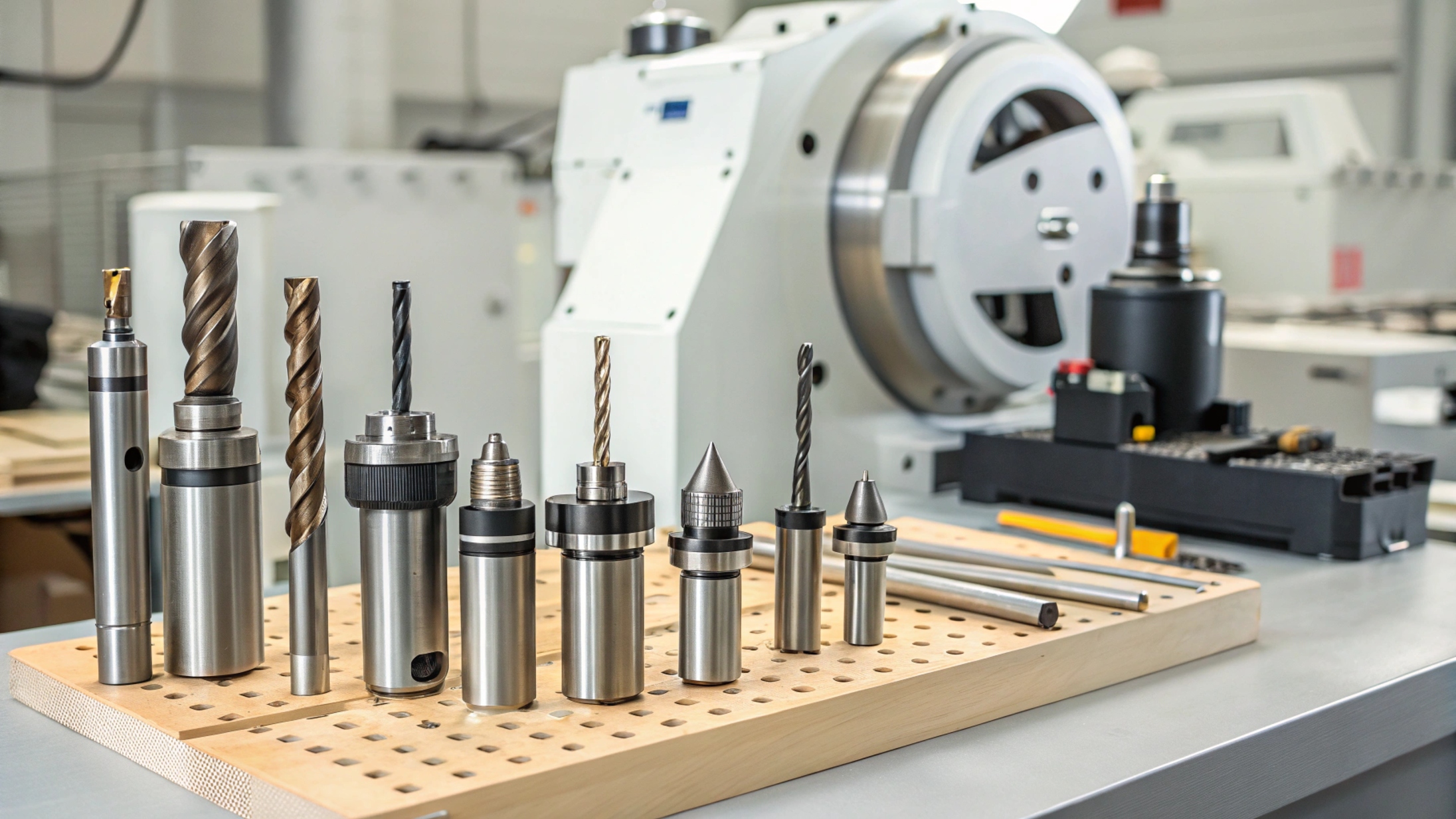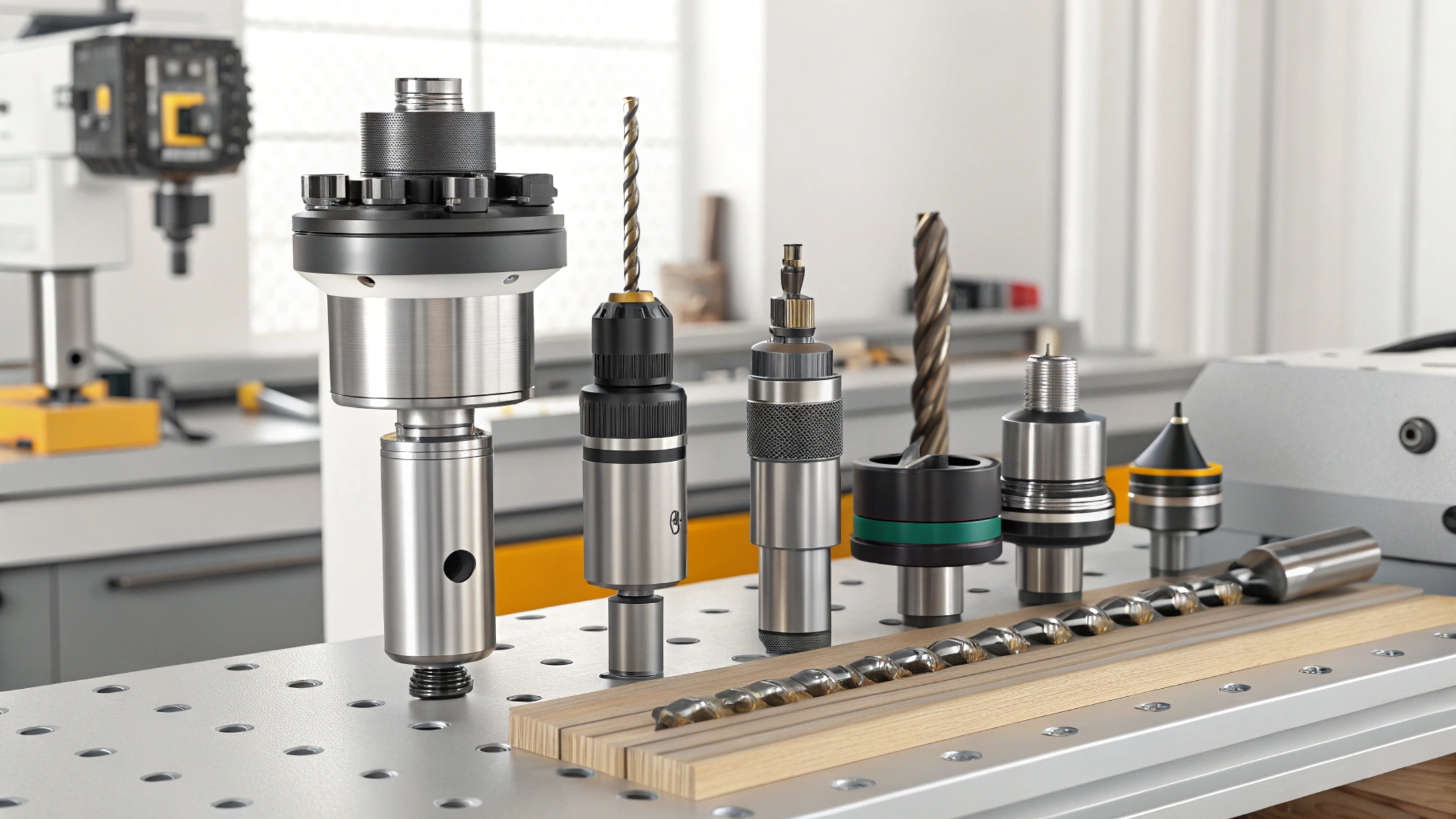
CNC cutting tools are essential for achieving precision and efficiency in machining processes.
Selecting the right cutting tools can significantly impact the quality of the finished product and the efficiency of the manufacturing process.
This guide aims to navigate through the types of CNC cutting tools available, factors to consider when selecting them, material compatibility, tool maintenance, and tips to enhance cutting tool efficiency.
Types of CNC Cutting Tools and Their Uses
CNC machining employs a wide array of cutting tools1, each designed for specific applications. Understanding the various types of tools available is crucial for making informed decisions.
1. End Mills
Typically used for producing flat surfaces, grooves, and complex shapes.
- Different Shapes and Designs: End mills come in various flute numbers and shapes (flat, ball, etc.) to suit different tasks.
- Applications: Ideal for machining materials like aluminum, steel, and plastics.
2. Drill Bits
Used primarily for creating holes in various materials.
- Types of Drill Bits: Standard twist drill bits, spade drill bits, and specialized bits for specific materials.
- Depth and Precision: They are available in various sizes for different hole depths and diameters.
3. Taps
Designed for cutting internal threads2 into materials.
- Tapping Tools: Straight flute taps, spiral point taps, and taper taps, depending on the required application.
- Applications: Essential for creating threaded holes for screws or bolts in components.
4. Reamers
These tools are used for finishing holes to specific diameters and provide high-precision surfaces.
- Types of Reamers: Straight reamers, tapered reamers, and adjustable reamers.
- Applications: Reamers are ideal for achieving tight tolerances on drilled holes.
5. Saws
Used for cut-offs and slice actions in various materials.
- Types of Saws: Band saws, circular saws, and reciprocating saws, each with specific uses.
- Applications: Ideal for cutting metals, polymers, and composites.
6. Specialty Tools
These tools are designed for specific tasks and might not fit into conventional categories.
- Examples: Tool and cutter grinders, engraving tools, and form tools tailored for unique geometries or finishes.
- Applications: Used in highly specialized applications across industries.
Summary
Understanding the different types of CNC cutting tools available is fundamental to making informed decisions that enhance efficiency and performance.
Factors to Consider When Selecting Cutting Tools
Choosing the right CNC cutting tool involves several critical factors that can influence the machining process.
1. Material Type
Understanding the material you are machining is essential in selecting the appropriate tool.
- Hardness: Materials vary in hardness, necessitating different tool materials (e.g., HSS for softer materials and carbide for harder ones).
- Machinability: Some materials are easier to machine than others, affecting tool selection and machining parameters.
2. Tool Geometry2
The geometry of the cutting tool plays a vital role in determining how effectively it operates.
- Flute Design: The number and shape of flutes influence chip removal and cutting efficiency.
- Cutting Edge Angle: Angles affect how aggressively the tool cuts and can impact surface finishes.
3. Cutting Conditions3
Review the machine's capabilities and the conditions under which you will be cutting.
- Cutting Speed and Feed Rate: Different tools perform at different optimal speeds. Consider the surface speed required for your operation.
- Cooling Requirements: For some materials, coolant may be necessary to prevent overheating and enhance tool life.
4. Tool Coatings4
Coatings can significantly enhance a tool's performance by improving wear resistance and reducing friction.
- Popular Coatings: TiN (Titanium Nitride), TiAlN (Titanium Aluminum Nitride), and coatings that provide thermal resistance.
- Benefits: Coatings can increase tool life and improve surface finish, especially when machining difficult materials.
Summary
By carefully evaluating these factors, you can select CNC cutting tools that enhance machining efficiency and meet project specifications.
Material Compatibility: Choosing the Right Tool for the Job
Matching the CNC cutting tool to the material being machined is critical for achieving optimal results.

1. Metals
When machining metals, the choice of cutting tool can drastically impact performance.
- High-Speed Steel (HSS)5: Suitable for softer metals; offers good durability and flexibility.
- Carbide Tools6: Preferred for hard metals; these tools can withstand higher speeds and temperatures, providing extended tool life.
2. Plastics
Plastics, while generally easier to machine, still require specific tools.
- Tool Selection: Use tools with sharp edges and specific geometries to prevent melting and ensure a good surface finish.
- Material Consideration: Different plastics will respond differently to various tools; for instance, acrylic requires particular attention to edge quality.
3. Composites
Composites require specialized cutting tools due to their unique composition.
- Tooling Considerations: Utilizing diamond-coated or carbide-tipped tools can help enhance the life and performance when machining composite materials.
- Risk of Delamination: Skilled selection of tool geometry and cutting parameters is essential to avoid damaging the composite structure.
Summary
Understanding material compatibility is fundamental in selecting appropriate cutting tools to ensure optimal performance and lifespan during machining.
Tool Life and Maintenance for Optimal Performance
Maintaining and monitoring tooling performance is vital to ensure extended tool life and consistent machining quality.

1. Monitoring Tool Wear
Keeping an eye on wear patterns can help anticipate tool replacements and adjust processes accordingly.
- Signs of Wear: Changes in cutting performance, surface finishes, and sound can indicate tool wear.
- Measurement Techniques: Employ techniques such as visual inspection, edge microscopies, or using tool wear monitoring systems.
2. Proper Maintenance Practices
Good maintenance practices are essential for maximizing tool life and performance.
- Cleaning: Regularly clean tools to prevent material build-up that can impact precision.
- Proper Storage: Store cutting tools in safe environments to avoid damage or wear before use.
3. Tool Replacement Strategies7
Implement effective tool replacement strategies based on consistent observation of wear.
- Regular Intervals: Maintain a schedule for tool replacements based on usage data or predicted wear rates.
- Emergency Spares: Keep spare tools on hand for critical operations to minimize downtime.
Summary
Proper tool maintenance and timely replacements are necessary for maintaining optimal performance in CNC machining operations.
Tips for Improving Cutting Tool Efficiency and Precision
Enhancing the efficiency and precision of CNC cutting tools leads to better production outcomes.
1. Optimize Tool Paths
Using software to optimize cutting paths can increase efficiency and reduce cycle times.
- CNC Programming: Invest time in programming efficient tool paths that minimize the number of moves required to complete parts.
- Simulation Software: Utilize CNC simulation software8 to test tool paths before actual machining to ensure they are as efficient as possible.
2. Adjust Cutting Parameters
Fine-tuning parameters will improve tool performance significantly.
- Feed Rates and Speeds9: Experiment with different cutting speeds and feed rates to determine optimal settings based on the tool and material.
- Depth of Cut: Adjusting the depth of cut can also influence efficiency and tool wear; consider incremental adjustments for optimal performance.
3. Utilize Workholding Devices
Effective workholding solutions can enhance machining precision and consistency.
- Clamping and Fixtures: Use appropriate clamping mechanisms to ensure parts remain stable during machining.
- Modular Fixtures: These allow for quick changeovers and adaptations, reducing downtime.
4. Continuous Training
Investing in workforce training can enhance efficiency and precision through better understanding of tools and machines.
- Operator Training10: Ensure operators are adequately trained in CNC programming, tool selection, and maintenance processes.
- Feedback Loops: Encourage operators to provide feedback on tooling performance to foster improvements.
Summary
Improving cutting tool efficiency and precision can be achieved through careful consideration of tool paths, adjustments to cutting parameters, effective workholding, and operator training.
Conclusion
Selecting the right CNC cutting tools is vital for achieving optimal efficiency and precision in machining projects. By understanding the different types of cutting tools available, considering material compatibility, and focusing on tool maintenance, manufacturers can enhance their processes significantly.
-
This resource will provide you with detailed insights into various cutting tools, their types, and their specific uses in CNC machining. ↩
-
Understanding tool geometry is crucial for optimizing cutting efficiency and achieving better surface finishes in CNC machining. ↩ ↩
-
Exploring cutting conditions helps in selecting the right parameters for improved machining performance and tool longevity. ↩
-
Learning about tool coatings can enhance your knowledge of improving tool life and performance in challenging machining tasks. ↩
-
Explore the advantages of HSS tools for machining softer metals, including durability and flexibility. ↩
-
Learn why carbide tools are essential for high-performance machining of hard metals, offering speed and longevity. ↩
-
Discover best practices for tool replacement to enhance efficiency and minimize downtime in CNC operations. ↩
-
Explore this link to discover top CNC simulation software that can help you optimize cutting paths and enhance efficiency. ↩
-
Understanding the impact of feed rates and speeds is crucial for maximizing tool performance; check this resource for insights. ↩
-
Learn about effective training strategies that can significantly enhance operator skills and improve overall machining efficiency. ↩

